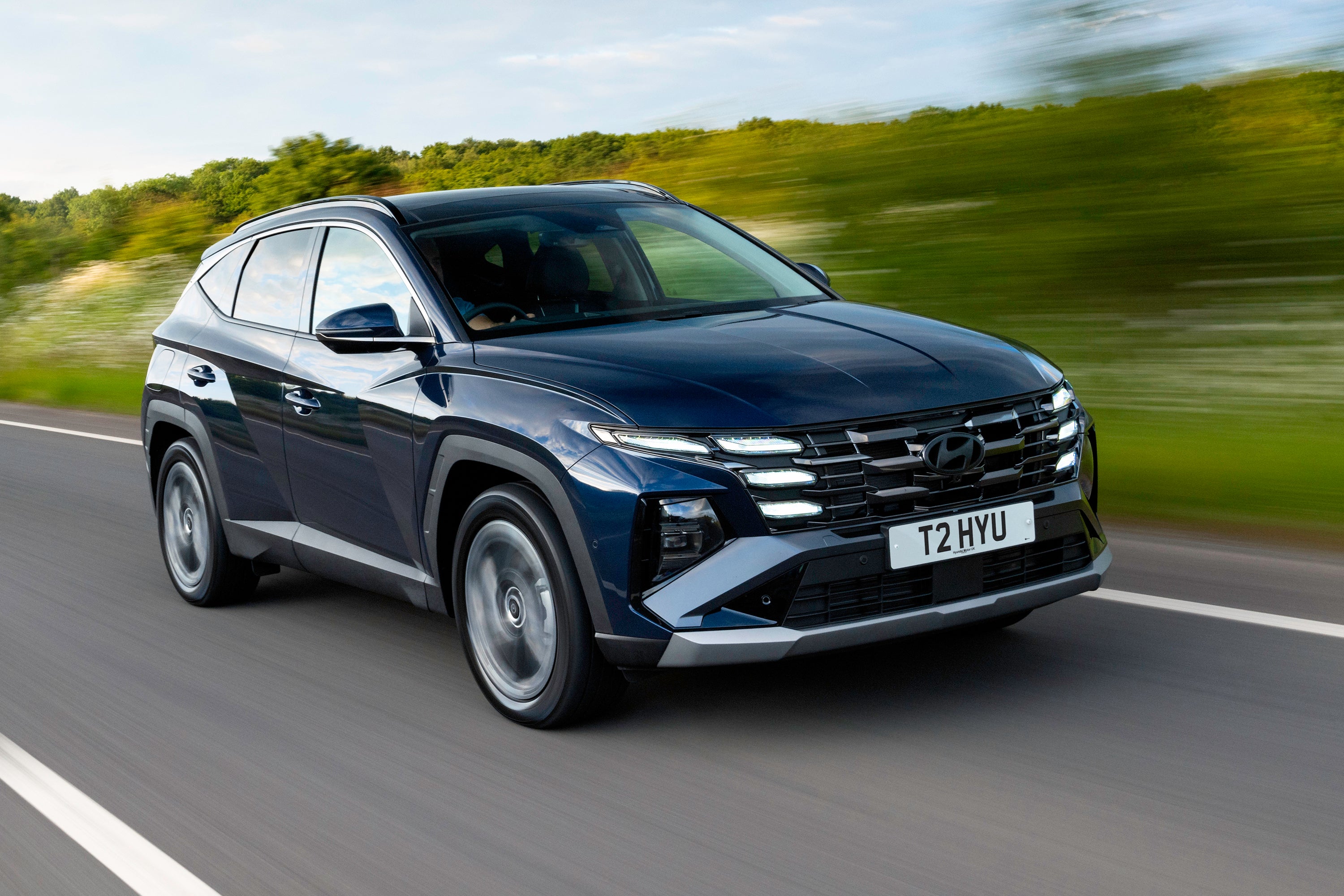Hyundai Tucson Review 2025: Price, specs & boot space
Written by Ivan Aistrop
Quick overview
Pros
- Bold appearance stands out from the crowd
- Interior is upmarket and very spacious
- Wide range of hybrid engines
Cons
- Responses from the DCT automatic gearbox can be a little tardy
- Ride quality can be harsh, especially with 19-inch alloy wheels
- It's really not the affordable SUV it once was
Verdict: Is the Hyundai Tucson a good car?
"The 2025 Hyundai Tucson combines masses of street cred with the kind of family-friendly practicality you'd want in an SUV. Hybrid power means it'll be cheap to run, even if it's not as cheap to buy as it once was. That's no surprise considering the Tucson's move upmarket (it now takes on posh rivals such as the Audi Q3 and BMW X1), but you do at least get a lot of standard kit for your cash."
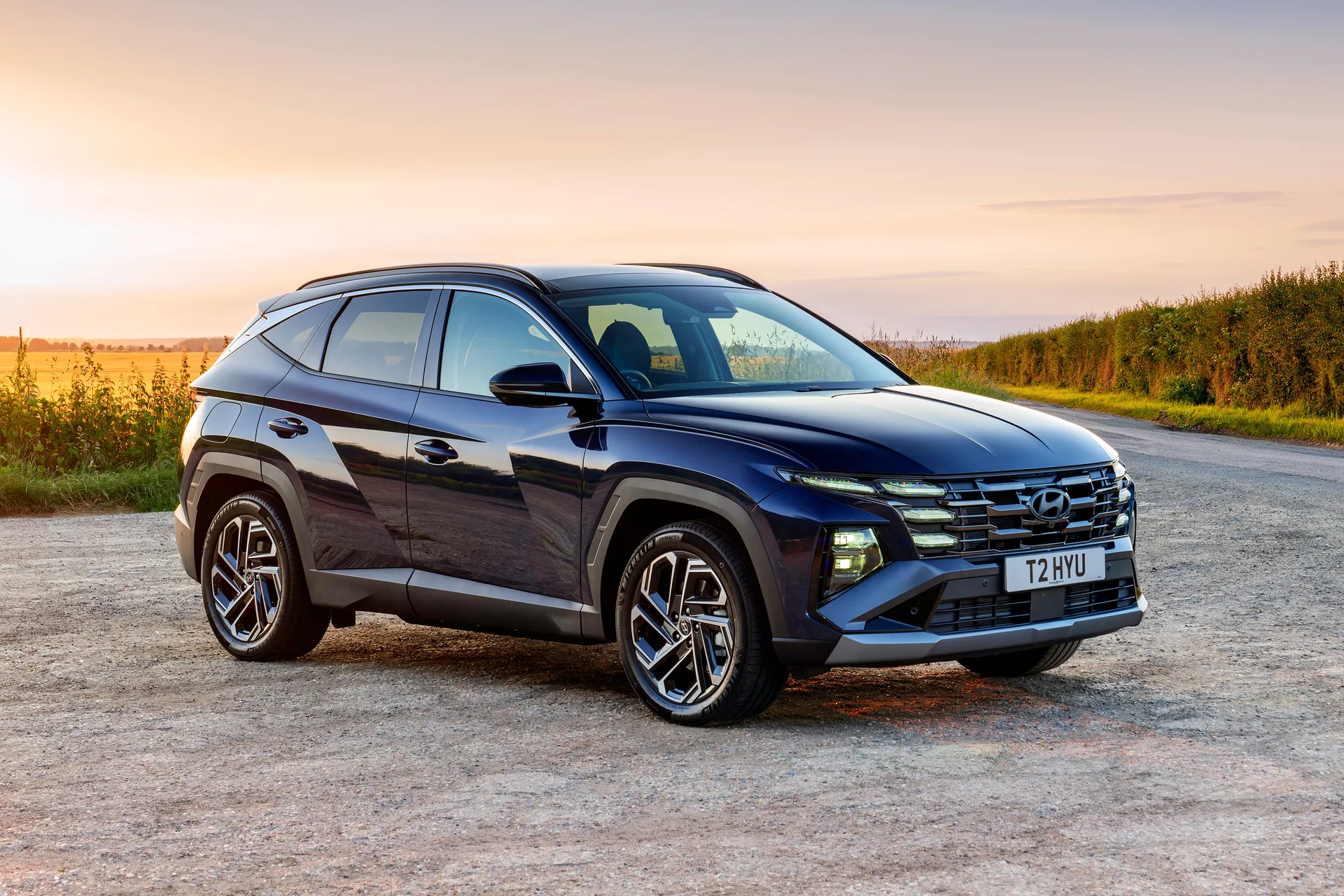
Gone are the days when the Hyundai Tucson undercut mainstream alternatives like the Skoda Karoq, Peugeot 3008 and Kia Sportage. You only need to look at the latest Tucson to realise that there's been a step change at Hyundai: the brand's family SUV is now utterly on trend and we reckon it's one of the best SUVs currently on sale. Find out why in our Hyundai Tucson review.
While the Hyundai Tucson's exterior will get tongues wagging, its interior is a little more conventional. But it still has the power to surprise owners of the previous Tucson, with its plush finishes and high-tech infotainment system. Fortunately, all this added style doesn't come at the cost of practicality. Measuring 4.5m long and 1.85m wide, it's roomy enough for a family of four or five (even the tallest of teenagers will be comfortable in the back), while the Tucson's boot space is one of the biggest in the class at up to 620 litres.
There isn't really a billy-basic Hyundai Tucson. The most affordable model is the Hyundai Tucson SE Connect (later renamed Advance), which itself has pretty much everything you could possibly want. There's a 10.25-inch navigation system, an equally large digital instrument cluster and a reversing camera. The Tucson Premium trim adds bigger wheels, chrome exterior styling, ambient lighting and a premium sound system, while the sporty N Line model features 19-inch alloy wheels, part-leather seats and, on the Tucson N Line S, a premium sound system. The top-spec Ultimate is fully-loaded, with ventilated leather seats, a panoramic glass sunroof and a powered tailgate.
You can no longer buy a Hyundai Tucson with a diesel engine. Instead, there's a line-up of petrol and hybrid power: including mild-hybrid, conventional hybrid and plug-in hybrid. Essentially, the more you're willing to pay, the further the Tucson can travel on electric power. The PHEV can cover around 40 miles from a charge before the petrol motor kicks in, which is ideal for those who want to cover a short commute during the week before hitting the motorway at the weekend. We've rounded up the best hybrid SUVs if you want to know more.
Hyundai has tried to make the Hyundai Tucson sportier than before, and it's certainly very composed in the corners. It's not as enjoyable to fling around as a SEAT Ateca, but it's more satisfying to drive than a Skoda Karoq. That comes at the expense of ride quality, though, especially as most Tucson models come with chunky alloy wheels and rubber band tyres.
Of course, the Hyundai Tucson's shift upmarket is going to hit buyers in the wallet. The most affordable models start from around £33,000, and prices rise to upwards of £45,000: that's getting on for Volvo XC40 or BMW X1 money. You do get a lot of equipment for the cash, though, and if you're not fussed about ordering a brand new car, there are lots of used examples.
Looking for a used car for sale? We've got 100s of Hyundai Approved Used Cars for Sale for you to choose from, including a wide range of Hyundai Tucson cars for sale. If you're looking for the older version, you need our Hyundai Tucson (2015-2021) review.
Is the Hyundai Tucson right for you?
If you need a spacious family SUV and want something that's going to turn heads, the Hyundai Tucson is a great choice. It's got a smart interior that's well kitted out, while the infotainment system is one of the best in the business. There's an engine to suit almost every buyer (although high-mileage drivers will have to look elsewhere for diesel power), and hybrid models ought to be cheap to run.
What other cars are similar to the Hyundai Tucson?
The Nissan Qashqai offers strong competition to the Hyundai Tucson, as does the Peugeot 3008 and the ever-popular Skoda Karoq. Other VW Group offerings include the SEAT Ateca and Volkswagen Tiguan, while there's also the Kia Sportage. You should also consider the Ford Kuga, Toyota RAV4 and Honda CR-V (especially if hybrid power appeals), while you may also wish to look at premium alternatives like the BMW X1, Volvo XC40 and Audi Q3.
Comfort and design: Hyundai Tucson interior
"The Hyundai Tucson's interior isn't as instantly eye-catching as its exterior. It'll be less divisive, though, and it certainly looks smart enough to challenge premium competitors."
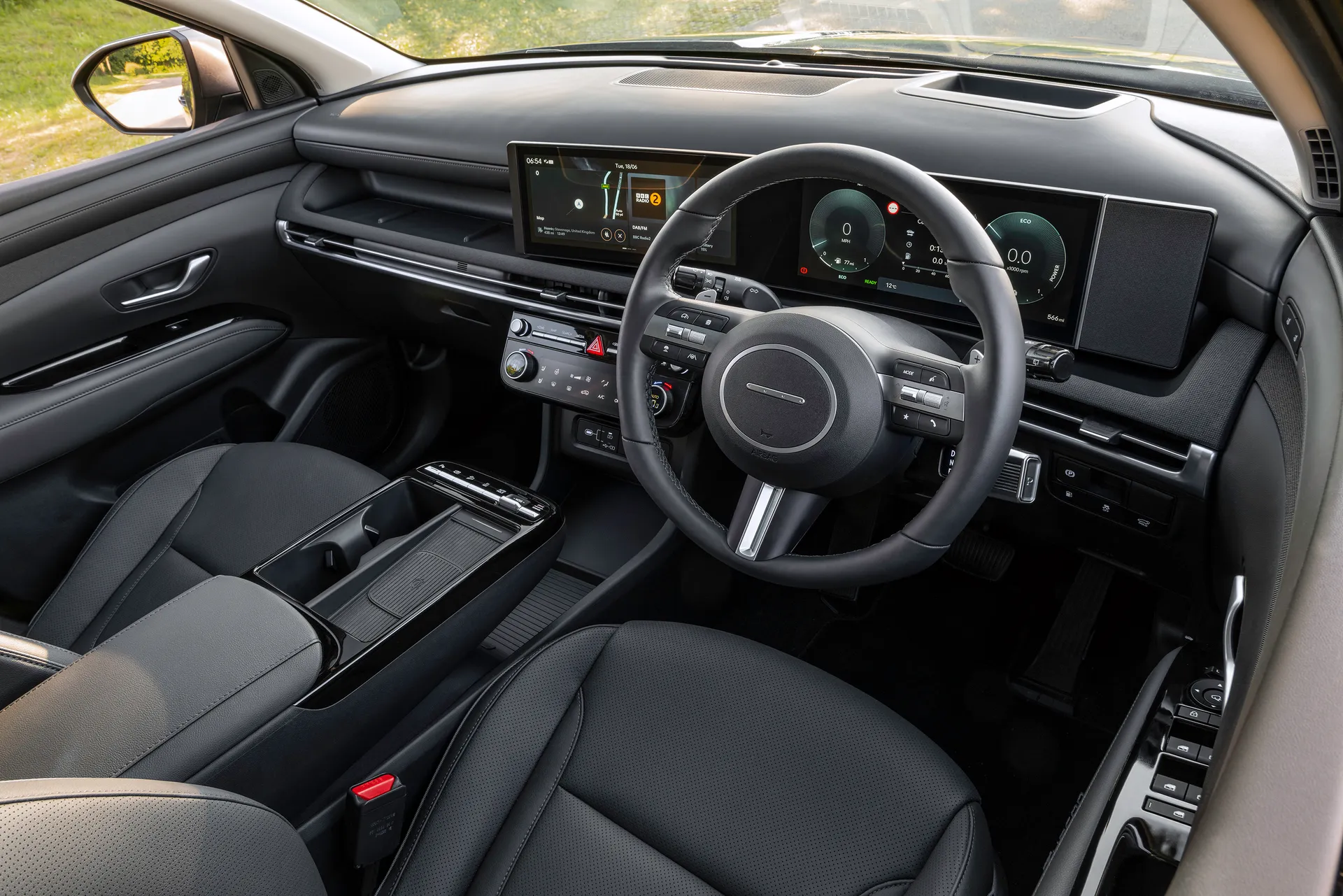
The Hyundai Tucson's interior represents a vast improvement over that of its slightly drab predecessor. We like the curved dashboard, while an abundance of different materials and chrome trim means it looks (and feels) classier than a Kia Sportage or even a Volkswagen Tiguan.
There's a flat centre console housing a wide range of touch-sensitive buttons. While traditionalists (us included) would prefer actual, physical controls for things like the climate control, at least you don't have to wade through endless menus to perform simple tasks with the Hyundai Tucson. It could look a bit cleaner and more minimalist, but it's all very useable. Automatic models get buttons rather than a traditional gear selector, which adds to the upmarket vibe.
The Hyundai Tucson's seating position isn't as high as some drivers will want from a family SUV, but we found it easy to get comfortable. Electric lumbar adjustment is standard across the range, but you'll need a top-spec Ultimate model for full electric height adjustment. The Ultimate even gets ventilated seats while the rest of the range (bar the SE Connect and Advance) features heated seats.
Quality and finish
If the 2025 Hyundai Tucson is serious about competing with upmarket rivals like the Volvo XC40, it has to be pretty much perfect in terms of interior quality. And it is. You won't find a flimsy finish or hard material.
A leather-wrapped steering wheel is standard across the range, while all but the entry-level SE Connect (later renamed Advance) feature ambient lighting. N Line and N Line S models feature part-leather seats, while the Ultimate trim level features full leather.
Infotainment: Touchscreen, USB, nav and stereo in the Hyundai Tucson
No matter which Hyundai Tucson you buy, you'll get the same excellent infotainment system. The central screen one of the best displays on the market, we reckon, with fast responses, crisp graphics and logical menu layouts. There's DAB radio as standard, of course, as well as Bluetooth, navigation, and Apple CarPlay/Android Auto.
A digital instrument display is also provided across the range: this is equally impressive, only really beaten by the Virtual Cockpit you'll find in an Audi Q3. A Krell premium sound system is standard on N Line S, Premium and Ultimate models, while a wireless phone charging pad features on all but SE Connect/Advance trim levels.
In early versions of the Tucson, the screens we mentioned were 10.25-inch items, but as of a facelift in August 2024, both screens were upgraded to 12.3 inches.
Space and practicality: Hyundai Tucson boot space
The Hyundai Tucson's boot capacity can accommodate between 558 litres and 620 litres of luggage, depending on the engine fitted (batteries eat into boot space on the electrified models to varying degrees). At its biggest, it's competitive against the likes of the Volkswagen Tiguan and Skoda Karoq, while it's significantly bigger than a Nissan Qashqai or Peugeot 3008.
The boot's usefully wide, while a false floor means there's not much of a lip for lifting items over. If you're after an electric tailgate, you'll need to find a range-topping Ultimate trim.
Boot aside, there's plenty of room in the Tucson. It's incredibly spacious up front, with a huge amount of head- and legroom. You get endless storage options, too, including a generous glovebox and large cupholders in the centre console.
Those in the back should be equally happy. It's more than spacious enough to carry two adults, although the Citroen C5 Aircross (with its three individual rear seats) is a better option if you need to carry more. Big rear windows mean it doesn't feel claustrophobic, and even with taller adults in the front, there's plenty of knee room.
Handling and ride quality: What is the Hyundai Tucson like to drive?
"The Hyundai Tucson's quite a heavy car, with plug-in hybrid models nudging two-tonnes. Combine that with the largest 19-inch alloy wheels and suspension tuned for sportiness, and the new Tucson simply isn't as comfortable as a Skoda Karoq."
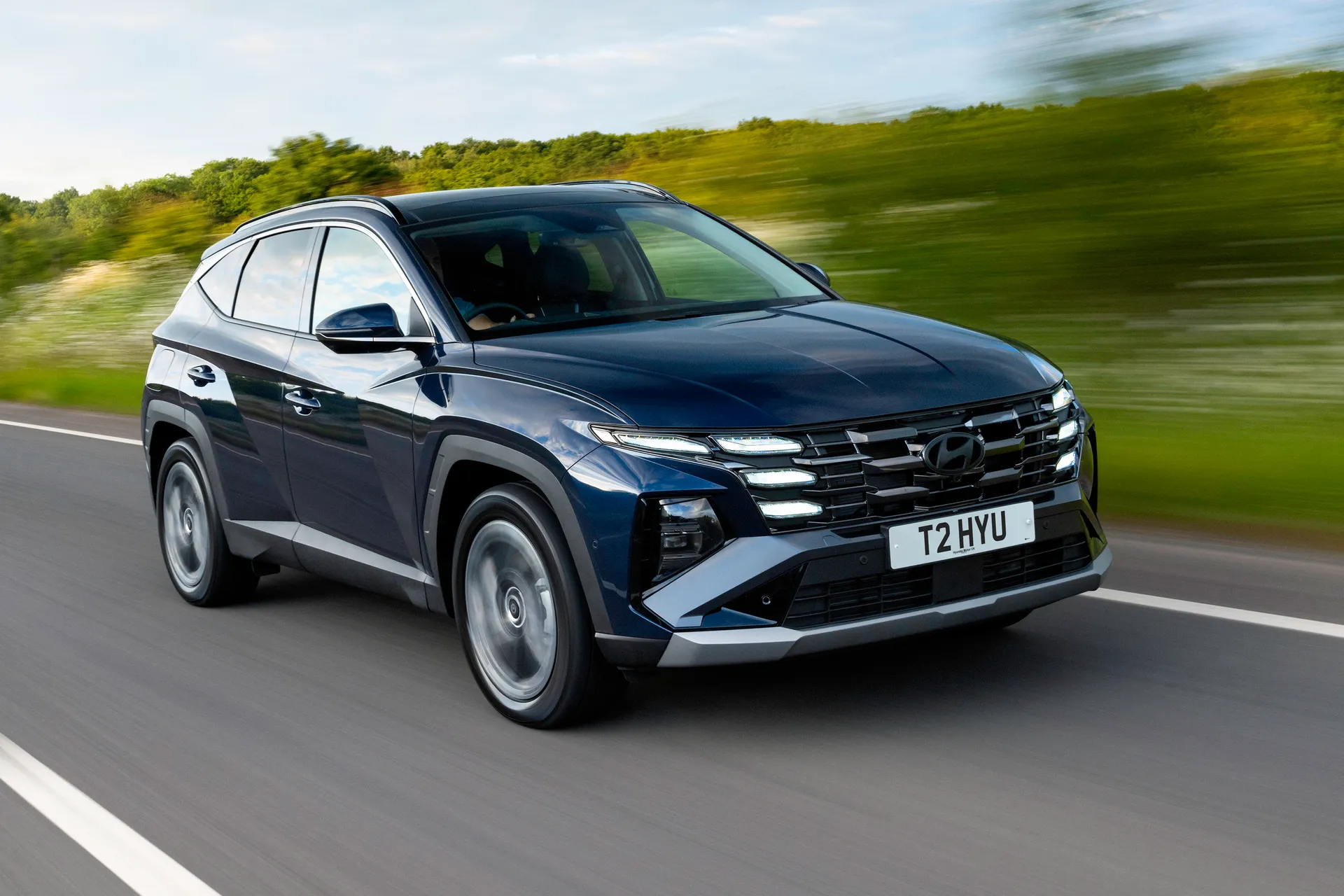
If you're looking for a comfortable ride , we'd recommend looking for a Hyundai Tucson with 17-inch (standard on the SE Connect and Advance) or 18-inch alloys (standard on non-hybrid Premium models). We've only sampled it with the 19s, though, and it's firm over uneven road surfaces.
On the flip side, it handles eagerly, with much less lean in the corners than a lot of rivals. The darty steering inspires confidence, while its wide tyres don't relinquish grip easily. For drivers expecting to venture into a muddy campsite, you might want to look for one with four-wheel drive. This is available on most of the hybridised versions, except some of the earlier ones.
The Hyundai Tucson is perfectly pleasant and easy to drive around town, where a reversing camera and parking sensors (both standard across the range) help with parking.
What engines and gearboxes are available in the Hyundai Tucson?
The Hyundai Tucson's entire engine line-up is based around one 1.6-litre petrol engine, which is available in a number of different power outputs and with varying degrees of hybrid assistance.
Early on in the Tucson's life, the entry-level model was a straightforward petrol (badged the 1.6 T-GDi), producing 150PS and available exclusively with a six-speed manual gearbox. This was also available with 48-volt mild-hybrid tech, giving it a small boost in economy, and a seven-speed dual-clutch automatic gearbox.
We never got to try the less potent Hyundai Tucson models, but we have sampled one with the same 1.6-litre engine and mild-hybrid technology (badged MHEV), but with output boosted to 180PS. It's no longer on sale as a new car, and it was only available on the pricier trim levels, and exclusively with the dual-clutch automatic gearbox and four-wheel drive. That meant it was really quite thirsty.
It was quick enough for a family SUV, accelerating to 62mph from a standstill in 9.0 seconds flat. The auto gearbox means it's not particularly relaxing to drive: it gets very flustered very easily, while the engine makes a bit of a din. Just trying to drive the mild-hybrid Tucson smoothly feels like a bit of a challenge.
Then there were the full hybrid or plug-in hybrid models. The standard 'self-charging' hybrid combined the same 1.6-litre petrol engine with an electric motor to produce 230PS, enough to cover 0-62mph in 8.0 seconds. The ability to set off under electric power alone makes this a particularly pleasant companion around town; but again, its automatic gearbox (this time a six-speed) can be a little clumsy.
The plug-in hybrid unit is aimed at company car drivers chasing tax benefits, but its 38-mile electric range means it could be ideal if you have a short commute. You can't buy a diesel Hyundai Tucson and we're not expecting that to change.
The range of powertrains changes slightly during a facelift in late 2024. The power output of both the entry-level petrol manual and the mild-hybrid automatics was upped to 160PS: the latter was made available with both front-and four-wheel drive. Meanwhile, the power outputs of both the self-charging hybrid and plug-in hybrid versions fell slightly, to 215PS and 252PS, respectively.
Refinement and noise levels
Hyundai's premium aspirations for the latest Tucson means there's been a clear concentration on noise levels. Hybrid power helps: the mild-hybrid models can coast to a stop with the engine off; hybrid Tucsons can set off under electric-only power; while plug-in hybrid derivatives can travel a few dozen miles before the petrol motor kicks in.
There's the usual wind noise at motorway speeds (this afflicts most family SUVs of this size), but it's certainly quieter than, say, a Nissan Qashqai.
Safety equipment: How safe is the Hyundai Tucson?
There's a whole range of active safety systems fitted as standard across the Tucson range. These include Forward Collision Assist (FCA) with car, pedestrian and cycle detection, Intelligent Speed Limit Assist (ISLA), Lane Follow Assist (LFA), Lane Keep Assist (LKA), Manual Speed Limit Assist (MSLA), Multi Collision Braking (MCA), and tyre pressure monitoring with individual tyre display.
The mid-range Hyundai Tucson Premium builds on this list of initialisms with Blind Spot Collision Warning (BCW) with additional Blind Spot Collision Avoidance Assist (BCA) on Hybrid models, Forward Collision Avoidance Assist (FCA) with additional Junction Turning Assist on DCT and Hybrid models, as well as Rear Cross Traffic Collision Warning (RCCW) and Safe Exit Warning.
The Hyundai Tucson has been awarded five (out of five) stars for safety by crash-test experts Euro NCAP.
MPG and fuel costs: What does a Hyundai Tucson cost to run?
"Hyundai's gone big on hybrid tech in the Tucson. As such, all models will be fairly cheap to run, although don't expect to buy a diesel model. That's a dirty word now."
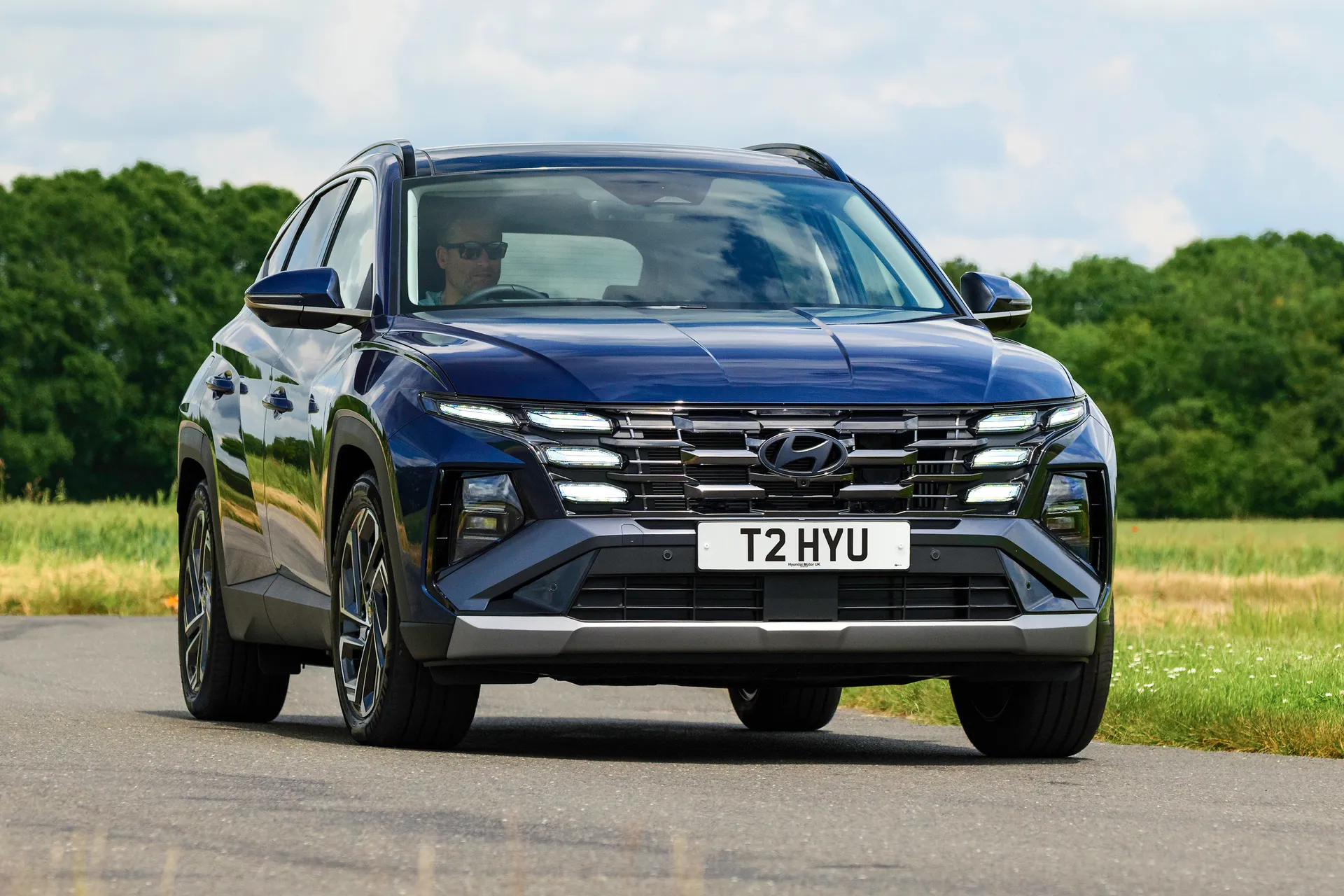
Even without hybrid assistance, the entry-level 1.6-litre petrol returns a respectable 41.5mpg in combined WLTP fuel economy tests. Add the 48-volt mild-hybrid system with the DCT automatic transmission and you should see around 44mpg.
The self-charging hybrid model is officially capable of 49.6mpg, but don't pay too much attention to the 200-plus-mpg claimed figure for the plug-in hybrid. Do, however, pay attention to its 38-mile electric range (later increased to up to 43 miles) – great if you've got a short commute and can charge the car on your driveway.
Hyundai Tucson reliability and warranty
Hyundai generally performs well in terms of reliability, so we wouldn't expect anything other than the utmost dependability from the latest Tucson.
The brand performs well in HonestJohn.co.uk's Satisfaction Index, achieving a score of 91.53% for reliability in the latest 2025 study. That was good enough to earn the brand a 10th-place ranking in the manufacturer reliability standings (out of 33 carmakers included).
A five-year, unlimited-mileage warranty should put your mind at rest, too.
Hyundai Tucson insurance groups and costs
Early versions of the Tucson are cheaper to insure than those from after the 2024 facelift. For example, the entry-level SE Connect versions of the pre-facelift car had insurance groupings starting from 12, while the equivalent post-facelift Advance versions start at a group 16 classification, with proportional rises to be found throughout the range of engines and trim levels.
We'd alway recommend shopping around for quotes before committing to a car, particularly if you're a young driver or live in a high-risk area.
VED car tax: What is the annual road tax on a Hyundai Tucson?
As of April 2025, the VED discounts for hybrid and electric cars that had previously existed were removed by the exchequer. That means all cars (built after 2017) are liable for the same flat rate of road tax regardless of what type of fuel they use, and that flat rate currently stands at £195.
However, watch out for the premium car tax. This applies to all cars with a brand new list price of more than £40,000 (even if you buy second-hand), meaning that several higher-spec versions of the Tucson are affected. Several more get pretty close to the threshold, and although there aren't many optional extras available, adding a few might push your car over the threshold, lumbering you with liability. It's worth avoiding, because if your car is liable, you'll pay an additional charge (currently £425) on top of the flat rate for a five-year period between years two and six of the car's life. If buying used, make sure you Google the reg of the car you're considering so you know exactly what you're letting yourself in for from a tax point of view.
Hyundai Tucson price
"Forget any ideas that the Hyundai Tucson is a budget choice. The most affordable model now costs more than £33,000 brand new, while top models have a list price of more than £45,000. That makes it just as expensive as a Volkswagen Tiguan and pricier than alternatives like the Skoda Karoq and the new Nissan Qashqai."
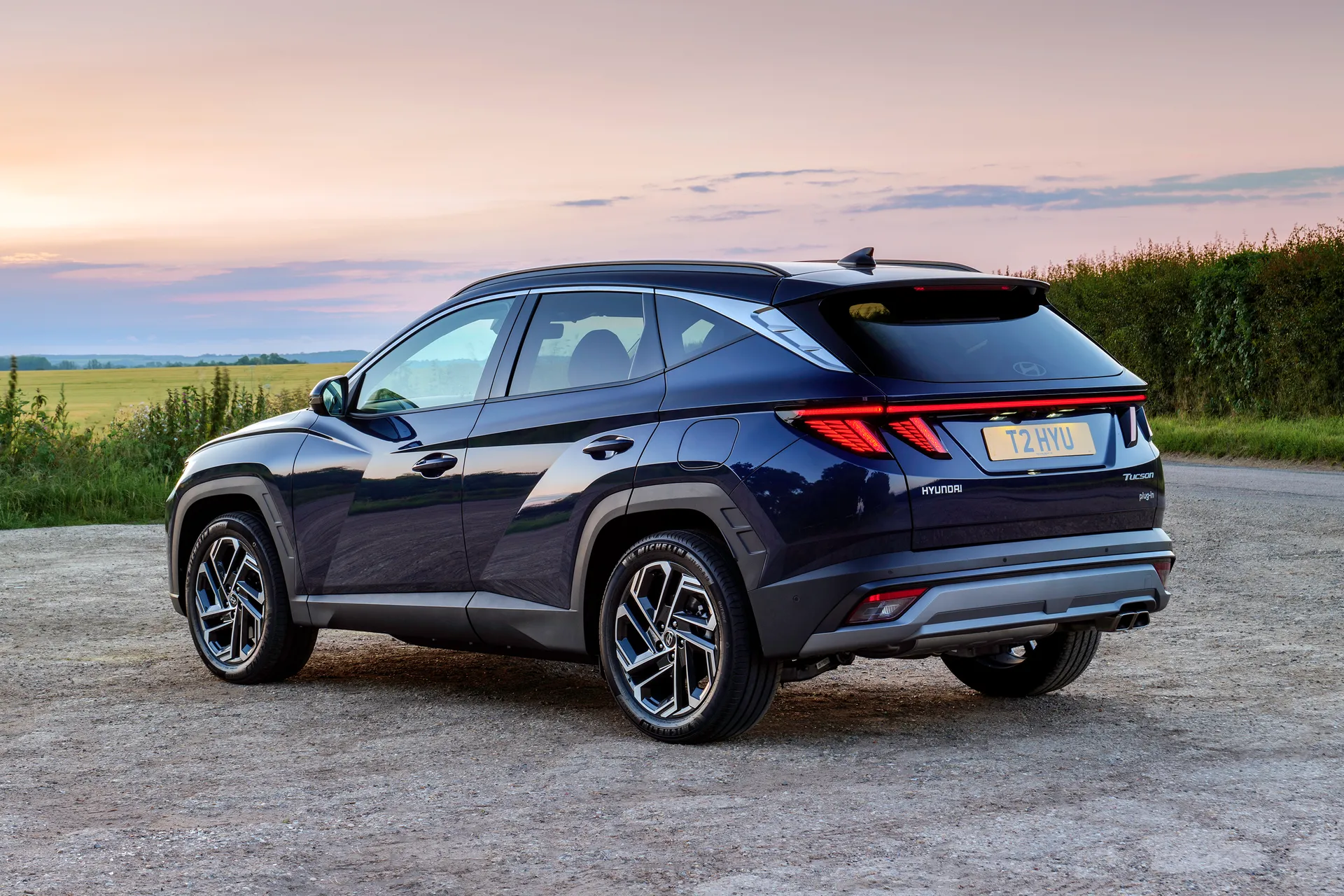
The Hyundai Tucson's relatively high retail price reflects its premium aspirations as well as the generous amount of standard equipment on offer. However, the car's popularity as a new car means there's loads and loads of choice on the used car market.
Browse our listings, and the cheapest cars - early SE Connect cars from 2021 with the non-hybrid engine - come in at around the £13,000 mark, although these will have fairly punchy mileages. You don't have to spend too much more to get yourself something a bit younger and fresher, though: around £17,000 will get you a 2023 example with around 40,000 miles on the clock.
You'll only have to spend a couple of grand more to get your hands on a self-charging hybrid, but a plug-in hybrid will be a lot more.
Trim levels and standard equipment
The Tucson range is split into a number of key trim levels: SE Connect (renamed Advance during the 2024 facelift), Premium and Ultimate, as well as sporty N Line and N Line S grades.
As you'd expect for a family SUV with a starting price upwards of £30,000, the Hyundai Tucson SE Connect/Advance is far from basic. Highlights include 17-inch alloy wheels, dual-zone air conditioning, the high-grade infotainment system and digital instrument cluster, cruise control, rear parking sensors and a rear-view camera. There's also a wide range of active safety systems including Forward Collision Assist (FCA) with car, pedestrian and cycle detection, Intelligent Speed Limit Assist (ISLA), Lane Follow Assist (LFA), Lane Keep Assist (LKA), Manual Speed Limit Assist (MSLA), Multi Collision Braking (MCA), and tyre pressure monitoring with individual tyre display.
The Hyundai Tucson Premium adds 18-inch alloy wheels (19-inch on Hybrid models), LED headlamps, ambient interior lighting, heated front seats and heated steering wheel, smart adaptive cruise control with stop go function (DCT and Hybrid models), front- and rear parking sensors with rear-view camera, and smart key with keyless entry and engine start/stop button. There's also a Krell premium audio system with eight speakers and a subwoofer, as well as a wireless smartphone charging pad. Additional safety equipment includes Blind Spot Collision Warning (BCW) with additional Blind Spot Collision Avoidance Assist (BCA) on Hybrid models, Forward Collision Avoidance Assist (FCA) with additional Junction Turning assist on DCT and Hybrid models, as well as Rear Cross Traffic Collision Warning (RCCW) and Safe Exit Warning.
The range-topping Hyundai Tucson Ultimate trim features 19-inch wheels, satin chrome door mouldings, leather seat trim with electric adjustment for the driver and front passenger seats – both with heat and ventilation function - and driver’s seat position memory function. Heated rear seats are standard, as well as three-zone climate control with separate rear-seat control, a panoramic sunroof with front section electric tilt and slide function, and a smart electric tailgate. Additional safety equipment includes Blind Spot Collision Avoidance Assist (BCA), Highway Drive Assist (HDA), and Rear Cross Traffic Collision Avoidance (RCCA).
The Tucson N Line looks quite distinctive, with its bespoke front grille, spoilers, bumpers and 19-inch alloy wheels. Inside, you'll find N-branded sporty seats with black suede and leather seat coverings, as well as red stitching. A dedicated N steering wheel arrives complete with an N logo. Further spec highlights include heated front seats, dual-zone climate control, parking sensors, Smart Key, wireless charging pad and ambient interior lighting. N Line S models additionally receive three-zone climate control, a tilt-and-slide electric panoramic roof, smart electric tailgate, a heated steering wheel, Krell premium audio with eight speakers and subwoofer and added SmartSense safety including Blind Spot Collision Warning and Rear Cross Traffic Alert.
Ask the heycar experts: common questions
How much is a Hyundai Tucson?
Which is better: the Hyundai Tucson or Kia Sportage?
Is the Hyundai Tucson good on fuel?
Get our latest advice, news and offers
Keep me updated by email with the latest advice, news and offers from heycar.
By submitting you agree to our privacy policy
